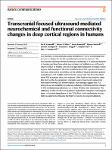Transcranial focused ultrasound-mediated neurochemical and functional connectivity changes in deep cortical regions in humans
| dc.contributor.author | Yaakub, SN | |
| dc.contributor.author | White, TA | |
| dc.contributor.author | Roberts, J | |
| dc.contributor.author | Martin, E | |
| dc.contributor.author | Verhagen, L | |
| dc.contributor.author | Stagg, CJ | |
| dc.contributor.author | Hall, S | |
| dc.contributor.author | Fouragnan, EF | |
| dc.date.accessioned | 2023-11-07T13:54:52Z | |
| dc.date.available | 2023-11-07T13:54:52Z | |
| dc.date.issued | 2023-09-01 | |
| dc.identifier.issn | 2041-1723 | |
| dc.identifier.issn | 2041-1723 | |
| dc.identifier.other | 5318 | |
| dc.identifier.uri | https://pearl.plymouth.ac.uk/handle/10026.1/21610 | |
| dc.description.abstract |
Low-intensity transcranial ultrasound stimulation (TUS) is an emerging non-invasive technique for focally modulating human brain function. The mechanisms and neurochemical substrates underlying TUS neuromodulation in humans and how these relate to excitation and inhibition are still poorly understood. In 24 healthy controls, we separately stimulated two deep cortical regions and investigated the effects of theta-burst TUS, a protocol shown to increase corticospinal excitability, on the inhibitory neurotransmitter gamma-aminobutyric acid (GABA) and functional connectivity. We show that theta-burst TUS in humans selectively reduces GABA levels in the posterior cingulate, but not the dorsal anterior cingulate cortex. Functional connectivity increased following TUS in both regions. Our findings suggest that TUS changes overall excitability by reducing GABAergic inhibition and that changes in TUS-mediated neuroplasticity last at least 50 mins after stimulation. The difference in TUS effects on the posterior and anterior cingulate could suggest state- or location-dependency of the TUS effect—both mechanisms increasingly recognized to influence the brain’s response to neuromodulation. | |
| dc.format.extent | 5318- | |
| dc.format.medium | Electronic | |
| dc.language | en | |
| dc.publisher | Springer Science and Business Media LLC | |
| dc.subject | Humans | |
| dc.subject | Animals | |
| dc.subject | Gastropoda | |
| dc.subject | Gyrus Cinguli | |
| dc.subject | Inhibition, Psychological | |
| dc.subject | Light | |
| dc.subject | gamma-Aminobutyric Acid | |
| dc.title | Transcranial focused ultrasound-mediated neurochemical and functional connectivity changes in deep cortical regions in humans | |
| dc.type | journal-article | |
| dc.type | Article | |
| plymouth.author-url | https://www.ncbi.nlm.nih.gov/pubmed/37658076 | |
| plymouth.issue | 1 | |
| plymouth.volume | 14 | |
| plymouth.publication-status | Published online | |
| plymouth.journal | Nature Communications | |
| dc.identifier.doi | 10.1038/s41467-023-40998-0 | |
| plymouth.organisational-group | |Plymouth | |
| plymouth.organisational-group | |Plymouth|Research Groups | |
| plymouth.organisational-group | |Plymouth|Faculty of Health | |
| plymouth.organisational-group | |Plymouth|Faculty of Health|School of Psychology | |
| plymouth.organisational-group | |Plymouth|REF 2021 Researchers by UoA | |
| plymouth.organisational-group | |Plymouth|Users by role | |
| plymouth.organisational-group | |Plymouth|Users by role|Academics | |
| plymouth.organisational-group | |Plymouth|REF 2021 Researchers by UoA|UoA04 Psychology, Psychiatry and Neuroscience | |
| plymouth.organisational-group | |Plymouth|REF 2021 Researchers by UoA|UoA04 Psychology, Psychiatry and Neuroscience|UoA04 REF peer reviewers | |
| plymouth.organisational-group | |Plymouth|Research Groups|FoH - Applied Parkinson's Research | |
| plymouth.organisational-group | |Plymouth|Users by role|Researchers in ResearchFish submission | |
| dc.publisher.place | England | |
| dcterms.dateAccepted | 2023-08-17 | |
| dc.date.updated | 2023-11-07T13:54:30Z | |
| dc.rights.embargodate | 2023-11-9 | |
| dc.identifier.eissn | 2041-1723 | |
| dc.rights.embargoperiod | ||
| rioxxterms.versionofrecord | 10.1038/s41467-023-40998-0 |


